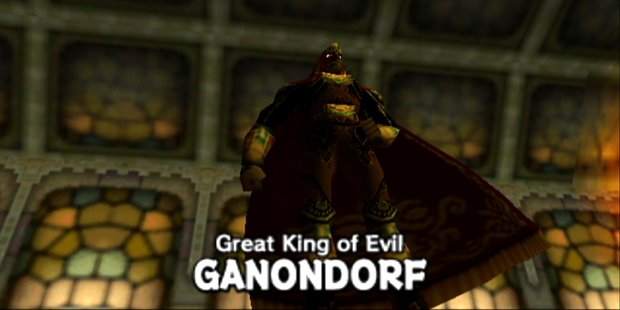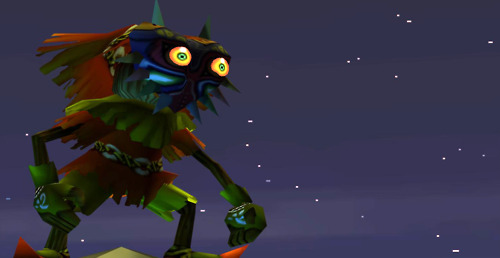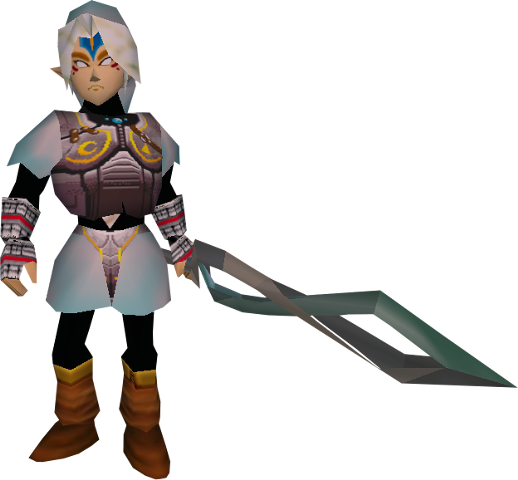Majora’s Mask Should Terrify You, and This is Why
Posted on December 22 2014 by Aaron Suduiko
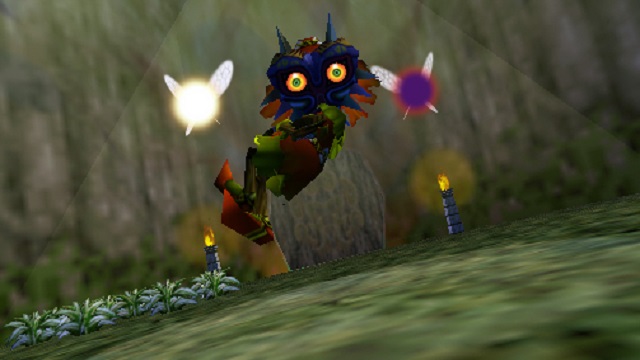
In this segment of With a Terrible Fate, I analyze the nature of morality in the universe of Termina, and present an argument for why this is uncomfortably different from the world of “Ocarina of Time.”
(A disclaimer to begin with: this series approaches “Majora’s Mask” from a theoretical lens, with which I analyze the game’s aesthetics and mechanics independently of conventionally accepted canon. This means that my articles will, at times, be at odds with the canonical interpretation of the game; I hope that, given this, they can offer insight and different perspectives on the game and its value, both in the series and beyond.)
It doesn’t take much effort to find horror stories inspired by “Majora’s Mask” online. We might think the reason obvious: “Majora” is arguably the darkest title in the Zelda canon thus far. It takes place in an inexplicable parallel world; the apocalypse is constantly occurring; and the moon has an enormous, menacing face. We can easily write off the disturbing undercurrent of “Majora” as a result of aesthetics such as these, but in this article of With a Terrible Fate, I want to offer an argument that the horror which pervades the game is more subtle and existential than that interpretation. I submit that the ultimate reason “Majora” continues to terrify us is that, as much as we want there to exist an evil for us to conquer, there ultimately exists no evil in the game.
Although I am often tempted to view “Majora” in a vacuum precisely because it is so wildly different from other Zelda titles, it is important to remember that it is the direct sequel to “Ocarina of Time,” and therefore in many ways engages with its predecessor in an artistic and philosophical dialogue. To that end, consider the premise of “Ocarina of Time”: though the game is undeniably complex and rich, the ultimate struggle is Link’s quest to save the kingdom of Hyrule from the barbaric usurper, Ganondorf.
Ganondorf is represented unequivocally as the paragon of power, unparalleled in his desire to subdue the entire world with his will. When Link jumps seven years forward in time to find that the Ganondorf has transformed the castle of Hyrule into a virtual citadel of darkness, it is unequivocal that we are meant to view Ganondorf as the archetype of evil, who essentially exists only that Link must stop him at all costs. (Ganondorf as a character, I should add, has become far more nuanced with the addition of games such as Wind Waker and Twilight Princess; but it is Great King of Evil Ganondorf to whom “Majora” responds.)
Where do we find the Great King of Evil in “Majora”? The Zelda veteran and video game initiate alike continually pose this question as they play through the game, and it is the inability to answer it which instills them with mounting fear throughout the course of the game. In the Zelda canon, the game’s ethos is divided into three cardinal virtues, collectively known as The Triforce. Link, Ganondorf, and Princess Zelda are each endowed with one piece of the Triforce — Courage, Power, and Wisdom, respectively. We can understand evil as a result of pure, unchecked, imbalanced power; but we do not even have grounds for believing that the Triforce obtains in the world of “Majora.” There is no mention of the Triforce throughout the entire course of the game, and although Link traditionally holds the Triforce of Courage, we do not have reason to think that the Triforce, a gift of three goddesses to the world of Hyrule, holds any sway in the parallel world of Termina.
The “villain” of this game is Skull Kid, a forest-dwelling child who is lonely and stole Majora’s Mask from the Happy Mask Salesman. The mask corrupted him and compelled him to attempt to destroy Termina by crashing the moon into it.
We don’t want to ascribe evil to a disturbed child whose only problem seems to be deep-seated loneliness; in point of fact, various entities throughout the game, including the giants who serve as the arbiters of Termina itself, directly advise us to forgive Skull Kid. So we try to nail the label of evilness to Majora’s Mask, the dark entity manifest — yet if we play through the entirety of the game, we find that the Mask too is not truly evil. (I offer below a synopsis to ground the rest of the analysis — skip ahead three paragraphs if already familiar with the game.)
The progression of “Majora” to its conclusion goes roughly like this: in order to save Termina from the wrath of Skull Kid and Majora’s Mask, Link must travel to four unique domains and liberate the four Giants, which Skull Kid sealed away with masks that transfigured them into monsters. After all four have been liberated, Link is able to confront Skull Kid atop a clock tower on the night of the Final Day, and the four Giants catch the moon as it falls, preventing catastrophe. Once the moon has stopped and Skull Kid has subsequently crumpled in a heap on the ground, Majora’s Mask takes over, literally tossing Skull Kid aside and possessing the moon itself, declaring that it will “consume everything.” In order to stop the Mask once and for all, Link is teleported to the moon, where he encounters a surreal scene of five children under a single tree on a lush, green landscape. Four of the children are running around the tree in play, each wearing one of the evil masks that had been used to seal the giants away. The fifth child sits alone under the tree, wearing Majora’s Mask itself.
One of the major elements of gameplay in “Majora” is the acquisition of masks: as Link progresses through the game and helps to heal people from their various difficulties and pains, he acquires masks representative of those people, each mask containing its own unique powers (the most important allow Link to transform into other heroes from the world of Termina). In total, there are 24 such masks for Link to collect throughout the game, though only a handful of these are required to complete the storyline. Based on whether or not Link collects all 23 masks available to him prior to the final confrontation on the moon, the game can end through two different means. If Link has not collected all the masks, he approaches the child wearing Majora’s Mask under the tree; the child notes that Link only has “weak masks,” and asks if Link wants to play. When Link says “yes,” a series of three heated battles against Majora’s Forms (Majora’s Mask, Incarnation, and Wrath) ensues in a surreal environment, after which the evil within the Mask is ostensibly defeated.
However, if Link has collected all 23 masks, he has the opportunity to acquire the 24th mask. He does this by playing hide-and-seek with the four children wearing the masks that bound the giants, after which they ask Link to give him the masks that he has. After giving away all his masks in this way, these four children leave; Link approaches the child wearing Majora’s Mask, who observes the following: “everyone has gone away, haven’t they? Will you play with me? You don’t have any masks left, do you? Well, let’s play something else. Let’s play good guys against bad guys. Yes. Let’s play that.” He then gives Link the 24th mask: the Fierce Deity’s Mask. The description of this mask, as provided by the game, is offered as a question: “could this mask’s dark powers be as bad as Majora?” After Link acquires the mask, the child says to him: “Are you ready? You’re the bad guy. And when you’re bad, you just run. That’s fine, right? Well, shall we play?” Then, the battle against Majora’s Forms begins.
Donning the Fierce Deity’s Mask transforms Link from a child into a ferocious adult with blank eyes and an enormous sword with a blade that resembles a Möbius strip or double helix. As the player launches bolts of blue energy out of this sword at Majora’s Mask, the battle that once was epic and trying becomes almost unfair to all three of Majora’s Forms: it becomes, in an ontological sense, child’s play. It is in relation to the Fierce Deity that we see Majora’s Mask cannot be appropriately described as “evil.” There are two lines of reasoning which support this, and together they form the basis for the game’s thesis that morality has no deeper grounding than what is arbitrary.
1. Majora is just as much a lonely child as Skull Kid is. What we see symbolized in the climax of “Majora” by the children playing under the tree is that Majora’s Mask subdued the four Giants of Termina because it was lonely and desperately wanted friends. This is corroborated in the story when Link liberates the final Giant, who bears no ill will and instead tells him to “forgive [his] friend.” Though the Giants were sealed away by Majora’s Mask, they sympathize with it because it and Skull Kid are ultimately characters with pathos: whereas Ganondorf represents the desire to subjugate the universe, both Skull Kid and Majora’s Mask represent the primal desire for unity and liberation from individuation. The Mask’s endgame is a testament to this: it inhabits the moon and seeks to unite the moon itself with the earth, destroying the distance that separates them.
2. The battle between good and evil is ultimately characterized as a game. When the Moon Child wearing Majora’s Mask engages Link underneath the tree (assuming Link has acquired the Fierce Deity’s Mask), he invites Link to play a game called “good guys against bad guys,” and gives Link the role of the “bad guy.” The Fierce Deity himself is described as a dark god; yet, the entire game was predicated on Link saving the world from evil. As we noted, the final boss fight actually plays like a trivial game when Link is in the form of the Fierce Deity, almost as though he is victimizing Majora’s Forms. What we see here is that, in keeping with the game’s motif of masks, morality itself has been framed as something that we can wear like masks — a fact from which we are lead to draw the conclusion that moralizing is a fundamentally artificial process.
The resulting metaphysical image that “Majora” paints is one where humanity fundamentally suffers from separateness, and seeks, like Skull Kid, to find existential comfort through grasping for something meaningful. Morality ultimately reveals itself as something that we postulate in order to comfort ourselves in just this way, although we believe it is something that inheres to the fabric of the world. So the terror the player feels mounting throughout playing “Majora” is the result of a nagging doubt, slowly growing in the back of their mind, that the moral quest on which Link initially embarked is not fundamentally moral at all — good and evil, rather, are a single artificial concept, like a Möbius strip trying to convince us that its one side is in fact two different sides.
It is also worth considering that the information we use to draw this conclusion depends upon acquiring the Fierce Deity’s Mask, which is an optional feature of the game, requiring completion of every optional quest within the game. This design feature of the game actually enhances its ultimate message: for the designers have made it possible for the gamer to progress from start to finish believing that their quest was one objectively motivated by morality, while the underlying substance of Termina simultaneously refutes that belief. This means that only those who actually go to the trouble of helping every person in the game’s universe, thereby acquiring every mask, are ultimately lead to the realization that morality is a construct — a narrative dimension which makes the ultimate realization of Termina’s nihilism that much more poignant.
This mental friction is even greater when the player has “Ocarina of Time” as background: for in “Ocarina,” as I argued earlier, Link absolutely is engaged in a moral quest to stop the very incarnation of evil, Ganondorf. Because “Majora” is the direct sequel of “Ocarina” and starts with Link chasing Skull Kid through the woods in Hyrule (Skull Kid had stolen Link’s Ocarina), we are encouraged to believe that the entirety of “Majora” is in some way continuous with “Ocarina.” Even when Link falls down a proverbial rabbit hole in the woods and follows Skull Kid to the parallel world of Termina, we want to believe that the Link as whom we are playing is that same Link who traveled time to confront the Great King of Evil in “Ocarina.” Yet I believe that, in review, we have far greater reason to believe that it is a parallel Link whom the player inhabits upon entering Termina, if it can be said to be Link at all.
Put aside the fact Termina’s Link can use a bow when Young Link from “Ocarina” could not; put aside the fact that the Song of Time, the tool for resetting Termina’s 3-day cycle, had a completely different metaphysical mode of operation in “Ocarina”; consider, instead, the conjunction of these three facts: first, we have seen there is no reason to believe that Link possesses the Triforce of Courage; second, we have seen that morality does not inhere to Link, and that the “ultimate form” offered to him by the game is actually that of an evil god; third, the narrative of the game is completely dependent upon Link donning masks to assume alternate forms, so that Link for most of the game is physically not even Link. While these facts do not entail that Link is a different entity in “Majora” than in “Ocarina,” that certainly seems to be the inference to best explanation. The Link of “Ocarina” is directed towards the goal of conquering evil without faltering, and the game is heavily focused on his own coming-of-age, featuring a seven-year time jump explicitly contrived to turn him into an adult capable of defeating Ganondorf. The Link of “Majora,” in contrast, appears as the classic existential Stranger, an unknown who exhibits unaffected agency in a world where meaning does not fundamentally obtain. This, I think, is another major source of why the gamer who specifically has already played “Ocarina” feels disturbed while playing “Majora”: they believe themselves to be playing the same character who occupied the world of “Ocarina,” and slowly, by painful degrees, they realize that they are someone who barely resembles that former Link.
This still only scratches the surface of a game that evades comprehension at every turn, but I hope it has provided at least the beginning of a framework for understanding the visceral reaction so many gamers have to this game. Staring into the eyes of Majora, we want to see evil staring back at us, yet find instead a lonely child; staring into the eyes of Link, we want to see someone familiar, yet in his place we see only the strange. I can imagine few better formulas for instilling existential discomfort in a gamer.
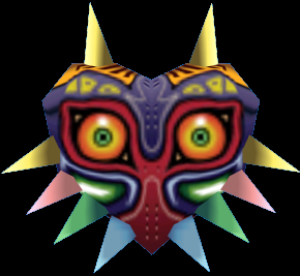 |
 |
Want to follow the analysis and theory? Read on at With a Terrible Fate.
Aaron Suduiko, Phillips Exeter Academy ’13, Harvard University ’17. Studies philosophy with a focus on developing new aesthetic theory with a grounding in the medium of video games. In 2013, he conducted a comparative analysis of role playing paradigms in video games (“Legend of Zelda: Majora’s Mask,” “Nier,” “Dishonored,” and “Deus Ex: Human Revolution”) and plays (“Six Characters in Search of an Author,” “The Man in the Iron Mask,” “Macbeth,” and “Flowers for Algernon.” He is the author of “With a Terrible Fate,”a twice-weekly analysis of “Majora’s Mask” that is published by Zelda Dungeon and is set to continue through the release of the 3D remake this coming spring. Suduiko is reachable at withaterriblefate@gmail.com.



